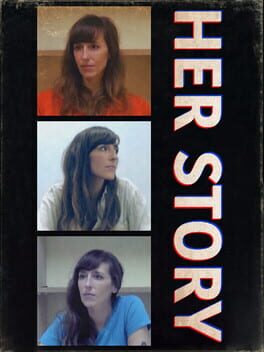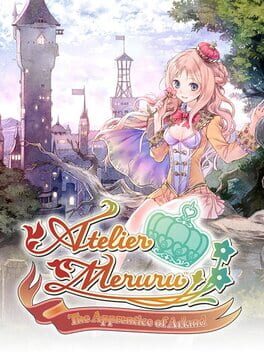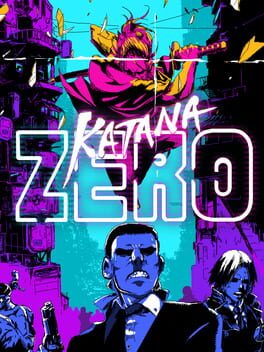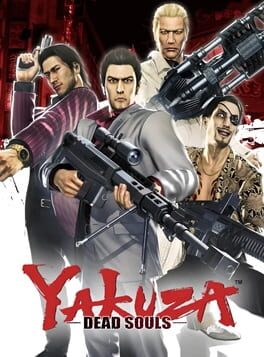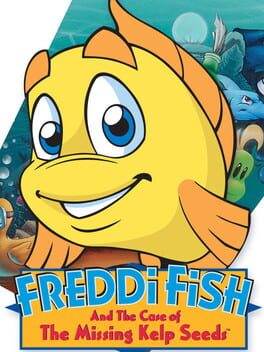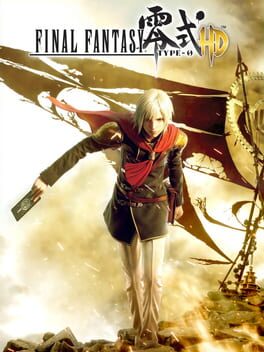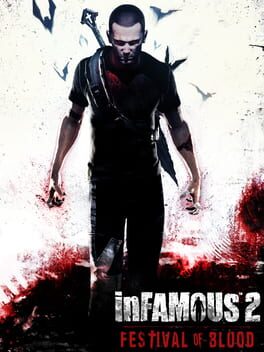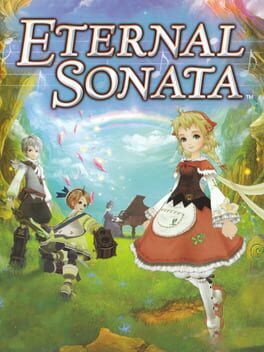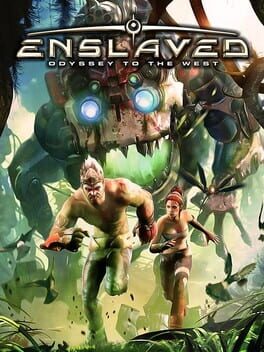Lucca202
BACKER
459 Reviews liked by Lucca202
Her Story
2015
Katana Zero
2019
I'm blown away.
I wasn't expecting anything unique of Katana Zero, until I read and heard it's praise in this community. Before that I thought this is just another game with 80's noir aesthetics, just another game with an atmosphere I might like or just another game with cool fighting mechanics that would be fun for a couple of hours or maybe just another try at Hotline Miami. And Katana Zero sure excels in all of that, but ends up being so much more. I can't praise this game enough for the way it's built. The fighting feels absolutely amazing, every ability is fun and feels good. The sound design is impeccable. The music ranges from the expected cool adrenaline-pumping synthwave tracks, to the most beautiful atmospheric soundscapes I've heard in a while. And I've been praising video game soundtracks a lot lately, this is one of my favorites. Every moving part in here is stylishly crafted to a level of perfection I haven't seen in a very long time.
The way it's story is told is also mind blowing to me, because of the way they used narrative and audiovisual tricks to tell it in a non-linear fashion through unexpected twists and turns. I've never would have expected to find any of this in Katana Zero. And maybe that's why it ended up being so impactful for me, because I've never played a "2D fighting game" that had me at the edge of my seat for its entirety, because I wanted to know more about the story and the main character.
I urge you to play this game if any of the info you get on it speaks to you. Whether that may be the aesthetics or the fighting or you now knowing that It's story is great. You won't be disappointed, that's a promise.
I wasn't expecting anything unique of Katana Zero, until I read and heard it's praise in this community. Before that I thought this is just another game with 80's noir aesthetics, just another game with an atmosphere I might like or just another game with cool fighting mechanics that would be fun for a couple of hours or maybe just another try at Hotline Miami. And Katana Zero sure excels in all of that, but ends up being so much more. I can't praise this game enough for the way it's built. The fighting feels absolutely amazing, every ability is fun and feels good. The sound design is impeccable. The music ranges from the expected cool adrenaline-pumping synthwave tracks, to the most beautiful atmospheric soundscapes I've heard in a while. And I've been praising video game soundtracks a lot lately, this is one of my favorites. Every moving part in here is stylishly crafted to a level of perfection I haven't seen in a very long time.
The way it's story is told is also mind blowing to me, because of the way they used narrative and audiovisual tricks to tell it in a non-linear fashion through unexpected twists and turns. I've never would have expected to find any of this in Katana Zero. And maybe that's why it ended up being so impactful for me, because I've never played a "2D fighting game" that had me at the edge of my seat for its entirety, because I wanted to know more about the story and the main character.
I urge you to play this game if any of the info you get on it speaks to you. Whether that may be the aesthetics or the fighting or you now knowing that It's story is great. You won't be disappointed, that's a promise.
Yakuza: Dead Souls
2011
holy shit
this game was something else
it's obviously a wild departure from what the series is usually known for but damn it all if it wasn't fucking awesome
from the atmosphere and the spectacle to the memorable tunes of this weird apocalypse Dead Souls surprised me with genuinely decent gunplay and good characterisation of the series' beloved characters, which also features quite possibly the sickest lineup of protagonists in the series
this game broke me multiple times in ways that still keep me up at night and I hope other people will share my suffering when it hopefully gets its much deserved rerelease
this game was something else
it's obviously a wild departure from what the series is usually known for but damn it all if it wasn't fucking awesome
from the atmosphere and the spectacle to the memorable tunes of this weird apocalypse Dead Souls surprised me with genuinely decent gunplay and good characterisation of the series' beloved characters, which also features quite possibly the sickest lineup of protagonists in the series
this game broke me multiple times in ways that still keep me up at night and I hope other people will share my suffering when it hopefully gets its much deserved rerelease
Eternal Sonata
2007
Gorgeous, original but a bit incomprehensible.
Frederic François Chopin was a famous Polish pianist who passed away on October 17, 1849 to to pulmonary tuberculosis. Who would have thought that last piece of rather morbid information would lead to such a unique and gorgeous game?
The story idea to Eternal Sonata is that on his deathbed, it is said that Chopin had a dream. During this period Chopin appears in another world in which everything is named after a musical term, this includes the other people that Chopin engages with in his fantasy adventure. This includes characters like Waltz, Tuba, Jazz, Falsetto, Viola, Rondo and Polka. The last of which is where his, and your dream to reality adventure starts. Polka is a young girl who was cursed from birth. She is going to die. Everyone dies, but Polka's fate is more known then others as she has the power of magic which will kill her sooner rather then later. Before she dies however, she wishes to accomplish something to help people. Chopin believing this is all a dream and that he too will soon die decides to accompany her on her quest.
With such an emphasis on a musical theme, where would Eternal Sonata be without good music to actually accompany it? Fortunately the music is fantastic, including in many areas some of Chopin's music. However the bulk of the game is made of original scores, and although reminiscent of Chopin's work, they are a lot more modern and fit the theme of the game perfectly.
Sound and story idea aside. Eternal Sonata is a gorgeous game visually. By this I do not mean the graphics are good in a technical sense, but rather in an artistic. No detail was spared when creating the world of Chopin's journey, even the smallest path from point A to B is a wonder to look at with a boundless array of colors used to infuse it with life. Flowers of all colors and shapes, waterfalls in ingenious places, leaves and petals in the wind are just some examples. Back when this was released on the 360 it really blew me away.
Gameplay wise Eternal Sonata is an action turn based RPG. Now usually as you travel further in an RPG the enemies get stronger to keep the game challenging. While this is true for this one as well, there is an added twist. The battle system itself evolves getting increasingly harder, yet at the same time more open. At the start of the game per each characters turn they have a set amount of time in which to perform actions from attacking, using special attacks or items. However this only moves down when you are moving and stops if you do, enabling you to plan your next move. As you progress other levels in the battle system are unlocked, so the timer doesn't stop once it starts, the time you get decreases. But there are bonus ingredients as well like being able to link several special attacks in a chain known as harmony attacks, speeding the battle speed up etc. There are 6 levels in all which are all slowly introduced so at no point do you feel overwhelmed.
The game is fairly short for an RPG at about 30 hours long, but for a game that is still value for money. Not only that but if you are after the achievements you will have to play it twice to get all 1000, as some only unlock on the second play through, which also becomes hard mode from a clear game save making it more challenging for those that found the first ride to easy.
Now for all the praise here, I have issues with this game in a few ways. Firstly, some of the dungeons your party travel through are quite large towards the end of the game. Yet there is no map, not even in the main menu in which you can get your bearings from. In the one optional dungeon in the game I got so frustrated at how confusing it was, I had to draw my own. Not a good sign.
Secondly, whilst nearly all the voice acting in the game is fantastic and a pleasure to listen to, one party member you receive will make you want to perforate your ear drums with hot knitting needles to avoid hearing it again.
Lastly, the ending to the game was not as well thought out as the rest of the title, and makes as much sense as a chocolate castle in the Sahara desert. Seriously, it's total bollocks..
However despite these few minor niggles, Eternal Sonata is an experience worth playing through and one I do recommend people try.
+ Gorgeous artwork, designs and color usage.
+ Lovely music.
+ Fun battle system.
+ Unique story Idea.
- Dungeons are long but no map.
- Voice acting is hit and miss.
- Ending is a load of nonsense.
Frederic François Chopin was a famous Polish pianist who passed away on October 17, 1849 to to pulmonary tuberculosis. Who would have thought that last piece of rather morbid information would lead to such a unique and gorgeous game?
The story idea to Eternal Sonata is that on his deathbed, it is said that Chopin had a dream. During this period Chopin appears in another world in which everything is named after a musical term, this includes the other people that Chopin engages with in his fantasy adventure. This includes characters like Waltz, Tuba, Jazz, Falsetto, Viola, Rondo and Polka. The last of which is where his, and your dream to reality adventure starts. Polka is a young girl who was cursed from birth. She is going to die. Everyone dies, but Polka's fate is more known then others as she has the power of magic which will kill her sooner rather then later. Before she dies however, she wishes to accomplish something to help people. Chopin believing this is all a dream and that he too will soon die decides to accompany her on her quest.
With such an emphasis on a musical theme, where would Eternal Sonata be without good music to actually accompany it? Fortunately the music is fantastic, including in many areas some of Chopin's music. However the bulk of the game is made of original scores, and although reminiscent of Chopin's work, they are a lot more modern and fit the theme of the game perfectly.
Sound and story idea aside. Eternal Sonata is a gorgeous game visually. By this I do not mean the graphics are good in a technical sense, but rather in an artistic. No detail was spared when creating the world of Chopin's journey, even the smallest path from point A to B is a wonder to look at with a boundless array of colors used to infuse it with life. Flowers of all colors and shapes, waterfalls in ingenious places, leaves and petals in the wind are just some examples. Back when this was released on the 360 it really blew me away.
Gameplay wise Eternal Sonata is an action turn based RPG. Now usually as you travel further in an RPG the enemies get stronger to keep the game challenging. While this is true for this one as well, there is an added twist. The battle system itself evolves getting increasingly harder, yet at the same time more open. At the start of the game per each characters turn they have a set amount of time in which to perform actions from attacking, using special attacks or items. However this only moves down when you are moving and stops if you do, enabling you to plan your next move. As you progress other levels in the battle system are unlocked, so the timer doesn't stop once it starts, the time you get decreases. But there are bonus ingredients as well like being able to link several special attacks in a chain known as harmony attacks, speeding the battle speed up etc. There are 6 levels in all which are all slowly introduced so at no point do you feel overwhelmed.
The game is fairly short for an RPG at about 30 hours long, but for a game that is still value for money. Not only that but if you are after the achievements you will have to play it twice to get all 1000, as some only unlock on the second play through, which also becomes hard mode from a clear game save making it more challenging for those that found the first ride to easy.
Now for all the praise here, I have issues with this game in a few ways. Firstly, some of the dungeons your party travel through are quite large towards the end of the game. Yet there is no map, not even in the main menu in which you can get your bearings from. In the one optional dungeon in the game I got so frustrated at how confusing it was, I had to draw my own. Not a good sign.
Secondly, whilst nearly all the voice acting in the game is fantastic and a pleasure to listen to, one party member you receive will make you want to perforate your ear drums with hot knitting needles to avoid hearing it again.
Lastly, the ending to the game was not as well thought out as the rest of the title, and makes as much sense as a chocolate castle in the Sahara desert. Seriously, it's total bollocks..
However despite these few minor niggles, Eternal Sonata is an experience worth playing through and one I do recommend people try.
+ Gorgeous artwork, designs and color usage.
+ Lovely music.
+ Fun battle system.
+ Unique story Idea.
- Dungeons are long but no map.
- Voice acting is hit and miss.
- Ending is a load of nonsense.
It always feels bad to rag on games that the public majority considers underrated, especially members of that category that underperformed financially. But unfortunately, I did not like Enslaved: Odyssey to the West, and so I have to criticize it in order to justify my opinion.
The idea of taking Journey to the West (or its abridged English translation Monkey) and adapting it into a video game format was an inspired idea. While I have not read Wu Cheng'en’s novel, I am aware of its epic scope, which naturally fits the parameters that a AAA video game can provide.
But alas, somewhere along the way, it was decided to loosely incorporate the plot of the classic, with the team instead opting to create their own lore and world. I think this was a missed opportunity to show how video games can be the artistic equivalent of great literature, but on the other hand I completely understand that adapting another person’s work is inherently restrictive on one’s creative expression. And so, Journey to the West was turned into Odyssey to the West: 7th Century Asia to post-apocalyptic America. By going this route, the team had the ability to conceive their own setting, one potentially rife with mythologies, commentary, or even satire.
And yet, this is the probably the biggest ball that Enslaved drops. Co-writer Alex Garland revealed that there was a deliberate attempt to be “reductive” with the game’s storytelling, and I have no problem with this approach. Showing instead of telling often yields greater world building rewards whilst avoiding the pacing issues that expository dialogue risks creating. The problem is, Enslaved is too quiet for its own good. Outside of vague references to a “war,” there’s no information on how exactly this place came to be. Robotic monstrosities called mechs roam the planescape, their AI acting like biological fauna; you get a notion that smuggling and slave trafficking are prominent enough, and perhaps tribes of like minded people still exist. But you will have to make so many assumptions because the game DOES NOT tell you anything. Why are the mechs still operational if no one is maintaining them? Why are there no other humans, neither friendly nor hostile? On that note, how is Monkey superhuman? Are any other clans trying to rebuild society? What caused this war and what ended it? Most video games would at least compensate for the lack of direct information by having external data available by way of collectibles (BioShock’s audio diaries, Arkham City’s Arkham stories). Enslaved doesn’t give you any of that. It’s vague to a fault, and this deliberate tactic on Garland’s part hurts the world because you have a very unique setting with its own mythos that I end up caring about as much as a level in Mario.
No seriously, think about that- you don’t care about how a particular area in a Mario game came to be because the point of it is to simply serve as a backdrop for the platforming action that’s about to take place. Enslaved falls into that same generalization- since its depiction of the United States doesn’t have anything narratively tangible to it outside of aesthetics, it’s essentially just a backdrop for the action of Monkey and Trip’s story. And again, it’s sad because this is a beautiful construct that is definitely brimming with a rich mythology, yet you don’t end up having any investment in it since Garland and co. don’t give you anything to chew on beyond obscure drops of knowledge that could be interpreted a bunch of different ways.
Is the adventure at least fun on its own merits? The answer is no. Enslaved is a title that starts off with a lot of potential- you have two prisoners who have escaped this floating prison and now one of them is forcing the other to help her get home in exchange for freedom. It’s a unique take on the “road movie” format, and instantly played to themes of freedom vs. security, as well as the effects of the judicial system on youths. Most importantly, it set the game on a serious note, which is what you want to do with a post-apocalyptic setting (assuming you’re not conceiving a tongue-in-cheek tale).
And yet, it falters because it doesn’t develop the relationship between the two characters well. Monkey and Trip are very interesting individuals, each with their own personality and view of this disturbing era they’ve grown up in. It’s a classic pinning of the grizzled veteran with the naïve rookie, albeit tuned to fit Enslaved’s persona. But that aforementioned complaint about things being too understated applies to the background of the protagonist Monkey. We don’t learn a damn thing about him! I mentioned his unexplained superhuman attributes, but practically everything else remains unclear- what was his childhood like, how did he become a proficient fighter, what are his views on morality in this dystopia, how did he end up on the ship, heck why is he shirtless all the time? You don’t get anything outside of a couple of small drops like his parents being killed by mechs, and it’s a little frustrating because you spend all this time with a guy you don’t end up knowing much about it. Ironically, it once again plays to the Mario schema of this man being more of a placeholder for action beats over a fleshed out individual.
This wouldn’t have necessarily been a glaring problem (for me anyway) if there was frequent conversations between him and Trip ala the way there was between Joel and Ellie in The Last of Us, but no, you don’t get much in the way of quiet moments. Most of their dialogues are focused on getting through sections of the world, whether that’s through procuring new equipment, scanning areas, or discussing the best plan of action. You need to either use those scenes to build up mutually-beneficial success stories or implement dramatic-laced parts when all the fighting is done. The former fails because, more often than not, Trip is merely a means to an end and Monkey does all the heavy lifting. And when she does get endangered, the reason I’m saving her is because her death means Monkey’s insta-termination, not because I care about her well-being. The two’s relationship just isn’t fleshed out enough to the point that I care about their future prospects together.
The biggest killer to the story, though, comes in the form of the second half of the game: the introduction of Pigsy. This guy (who is apparently another loose homage to a character from Journey to the West) is the epitome of lazy writing: a stereotypical comic relief slob. Credit where credit is due- I didn’t end up hating him since he actually serves a purpose, but the biggest downside is that he absolutely kills the serious tone that was established in the first half. Enslaved goes from a hard T to a flat-out E10 rating because of him: the tonal shift is THAT bad. If the whole narrative had been tongue-in-cheek, it’d be one thing, but because it wants to be a serious tale, the decision by Garland to change it up makes no sense. And considering the humor is often juvenile, it honestly took me out of the immersive nature (am I seriously hearing love triangle jokes in a dystopia)?
Another overhead issue with the narrative design is that it’s tied to a game design that’s too cinematic for its own good. This was always going to be a risk given the involvement of filmic artists like Garland and Andy Serkis. Movies are, of course, a very different medium from video games- they are purely linear, wherein everything about the story is out of your hands. Video games (yes, even walking simulators) are different because the player controls the pacing of the plot. And because they have that control, they need a sufficient number of activities to do: activities that simultaneously advance the story, keep them entertained, don’t hurt pacing, and develop the characters.
You already know Enslaved significantly falters on the latter front, but all the others are failures too. With the first, it’s quite clear that Garland and co-writer Tameem Antoniades were thinking of the plot purely in macro terms: escape the prison, get to Trip’s home, find Pigsy, etc…In AAA video games, you HAVE to think about the micro picture since that is what will be taking up most of the player’s time (i.e., what is the player doing in-between A and B).
Because that was the primary focus of the writers, that in-between is chockful of the most repetitive gameplay loop I have experienced since Epic Mickey- Monkey and Trip arrive in a plane, find it to be occupied with mechs, Trip sends a drone to scan, and then Monkey proceeds to clear a path forward. Repeat ad nauseum. It gets old fast and stops being fun. There was a pathetic attempt at introducing some non-linearity into this by way of having some stealth options to approaching areas or malfunctioning enemies with different ways of getting to them, but it’s very half-assed: you don’t want to avoid fighting because defeated enemies yield the game’s currency for upgrades, and finding the quickest path to get to the malfunctioned bot is usually far more cumbersome than just going in guns a-blazing.
The only time this pattern is broken up is via boss fights (all of which are lame, boring slogs) or surfing with Monkey’s cloud disc device (reference to Goku’s Flying Nimbus from Dragon Ball?), which is very very very underutilized considering how fun its mechanics are.
For all my ranting, there is one redeemable part of the whole narrative aspect and that’s the performances. Much has been made about Andy Serkis’s role as Monkey, and he is indeed amazing, donning his best Steven Blum impersonation whilst also pioneering the amazingness of motion capture. However, a lot of people have been sleeping on Lindsey Shaw’s performance as Trip: in my opinion, she more than equaled Serkis, an amazing feat considering this was her first mocap role. She does a great job conveying the innocent nature of Trip, making the tragic scenes all the more affecting. There was chemistry between the two, and while it’s a shame that it’s not capitalized on more than it should have been, I’d be lying if I said they didn’t make the most of their limited convos. And, though I was not big fan of the character, credit to Richard Ridings for also giving a solid portrayal of Pigsy.
Graphically, Enslaved came out during the Autumnal years of the Xbox 360/PS3’s life, and it looks gorgeous. There is a genuinely-realized vision of a post-apocalyptic USA: humanity has abandoned all pretext of metropolitan civilizations, leaving urban structures overwrought with vegetation. While there’s a surprising lack of pollution, the remnants of consumer culture lay prevalent in the cityscapes with furniture, TVs, papers, and other simulacra everywhere. Industrial components are strewn everywhere (serving as the footholds for most of the game’s platforming), and yet all their appearance (alongside the mechanical factories of the second half) avoid falling into steampunk territory, crafting their own visage. Indeed, Enslaved looks like a stereotypical Xbox 360 game: photorealistic models and environs that are stylized enough to prevent them from aging badly. Though the texturing isn’t as consistent as I would have liked it to be, nothing stands out (outside of the occasional rendering zigzag on Monkey during the cutscenes): there’re no hitches, no misplaced hues, and the only bug I experienced was caused upon trying to do any set-up change in the options menu (my screen would either get really small upon implementing the change or massively drop in graphical quality, forcing me to relaunch the game as a whole).
That being said, one reason I didn’t get immersed into the visual beauty of Enslaved’s America is that everything feels too bright. And no, I don’t mean from a lighting perspective (the lighting, for the record, is primarily static, with every luminescence being perfectly suited to whatever area you are in)- the sun is out for 99% of the game. No, what I mean is that the schemes rely too much on warm colours, making everything feel unintentionally cheery. Obviously, in a real-world scenario, you wouldn’t be seeing depressing tones in a humanless world, but this is where artistic license comes into play with fictional depictions. Enslaved’s dystopia is so oversaturated at times, that it can’t help but feel like a paradisical place. And maybe that was partly the intention of the designers, but for me personally, I couldn’t help but not think of this as an apocalyptic wasteland rife with kidnappings, murdering robots, and no life.
Other notable feats- shadow mapping is terrific and game runs better without motion blur (IMO) and Monkey blinks!
Sound design is another area where the game drops the ball hard. The editing, in general, is terrible: you don’t get a good balance between SFX and score- even when I turned down the music volume I couldn’t make out the noises half the time. Not that it would’ve mattered because there’s a significant lack of impact with the sound. Footsteps feel light, and combat noises like enemies getting hit don’t have any weight to them minus the finishers. The exact same “chink” is repeated no matter the kind of mech that you’re whacking away at, and nothing else stands out. Sound really feels like an afterthought here- even ambient noises like birds squawking are blatantly stock in nature. It’s all so generic.
I wasn’t a fan of Nitin Sawhney’s score either. Outside of the beautiful main theme, nothing particularly caught my ear and stayed in my head. He does the quiet moments well enough, but because there are so few of them, the bulk of his compositions are focused on actiony tunes that either aren’t engaging or too background-like for my liking.
Finally, there’s the gameplay, and it’s decent enough. You have your standard light and heavy attacks, however there’s a lack of a combo system, meaning nothing flows together as well as it should. You won’t be able to jump between enemies, meaning your only tactic is to wail on a mech until it’s destroyed or another guy tries to attack, in which case you either block or dodge. The lack of good sound makes kills unsatisfying (save the finishers, which were badass), the lack of flow means battles are inherently 1v1 in nature, and the lack of multilateral moves means you’re going to be repeating the same pattern for most of your encounters. And yet, for all my issues, it gets the job done. The ability to charge up your staff for a stun, purchase counter strikes from the store, or pull out your plasma rifle for a quick shot gives just enough diversity to your actions. I also liked how enemies were quick on their feet, meaning even a mech that’s been hit won’t be out long enough for you charge attack, meaning will have to block, evade, or get a quick weak strike in. Should there have been more combat moves to purchase in the store? Yes, but I’m not going to bother fretting about something that isn’t there when I didn’t get frustrated by what was there.
I did dig the parkour- the animators did a good job replicating the feel of a humanoid monkey with the climbing and jumping animations. However, the design was purely linear- I would’ve liked to have seen this approach to parkour applied on a grander scale (i.e., give more avenues to begin ascending up as opposed to a single pipe to climb- be more like Assassin’s Creed!). Also, animation transitions between static and motion poses are non-existent: it’s a hard cut.
The movement for Enslaved in general is lackluster courtesy of one missing element- jumping. Seriously, you cannot jump at all, which seems deliberately done to gridlock players from accidentally causing a break since the world is deliberately designed to be nothing but linear paths. This means simple things like descending down or climbing up are turned into “find the correct entrance,” when a slightly more open-minded approach to game design would’ve yielded greater fruit. And I know it was possible considering the damn Cloud allows you to jump (probably why it’s barely in the game).
So yeah, overall Enslaved: Odyssey to the West was a disappointment for me. I was hoping it’d be an underrated gem in the vein of Alpha Protocol, but it’s something that seems to have garnered a following more-so due to its celebrity status than anything in it. The uniqueness of the world is hampered by frustratingly vague storytelling, repetitive gameplay sections, and lack of dialogue. It also suffers from The Last of Us problem of exploration being at odds with story progression (though to a far lesser degree since character interactions aren’t as well-developed as in TLOU). Gameplay is decent, sound design abysmal, and graphics are very good (though your milage will vary on the color scheme). Despite terrific performances, I wasn’t able to get immersed into the setting, and with tonal inconsistencies it seems that the writers weren’t either. None of this is even getting into the ending, which is a sudden hodgepodge of unearned philosophical depth that Spectre and Ready Player One ripped off of.
With regards to the story DLC, Pigsy’s Perfect 10, I obviously had low expectations going into it given my mixed-to-negative overview of Pigsy. Credit to Ninja Theory because they actually do a good job here of creating an entirely different genre within the same world- this shows their apt for making decent cover shooters. You also get a variety of tools that create different gameplay scenarios in a way that was never realized in Enslaved. The story is obviously humorous in nature, but because it is this way from the get-go the atmosphere doesn’t get tanked. It does try to get serious by way of emphasizing the relationship between Pigsy and an AI robot of his called Truffles, but I found the latter more annoying than cute (maybe that was the intention behind Ninja theory: create a more annoying character to make your protagonist more likeable by comparison). The level design is a little more diverse than what we saw in the main campaign, music more consistent, and sound design (particularly mixing) stronger.
The shortness of the narrative also benefits things tremendously. It does create some continuity errors though (Pigsy is shown living in a junkyard here and finds the Pigsyland area later, whereas in Enslaved it’s depicted as being his defacto home), but I think it was overall a good initiative on Ninja Theory’s part. If I had liked the main game more I think I would’ve liked this, but as it stands it’s an okay DLC on its own merits. Richard Ridings definitely deserves props for his consistent delivery here. Another small thing I appreciated was how, every time you collected a new collectable (sexy magazine, food item), there was a unique reaction from Pigsy for each one.
The idea of taking Journey to the West (or its abridged English translation Monkey) and adapting it into a video game format was an inspired idea. While I have not read Wu Cheng'en’s novel, I am aware of its epic scope, which naturally fits the parameters that a AAA video game can provide.
But alas, somewhere along the way, it was decided to loosely incorporate the plot of the classic, with the team instead opting to create their own lore and world. I think this was a missed opportunity to show how video games can be the artistic equivalent of great literature, but on the other hand I completely understand that adapting another person’s work is inherently restrictive on one’s creative expression. And so, Journey to the West was turned into Odyssey to the West: 7th Century Asia to post-apocalyptic America. By going this route, the team had the ability to conceive their own setting, one potentially rife with mythologies, commentary, or even satire.
And yet, this is the probably the biggest ball that Enslaved drops. Co-writer Alex Garland revealed that there was a deliberate attempt to be “reductive” with the game’s storytelling, and I have no problem with this approach. Showing instead of telling often yields greater world building rewards whilst avoiding the pacing issues that expository dialogue risks creating. The problem is, Enslaved is too quiet for its own good. Outside of vague references to a “war,” there’s no information on how exactly this place came to be. Robotic monstrosities called mechs roam the planescape, their AI acting like biological fauna; you get a notion that smuggling and slave trafficking are prominent enough, and perhaps tribes of like minded people still exist. But you will have to make so many assumptions because the game DOES NOT tell you anything. Why are the mechs still operational if no one is maintaining them? Why are there no other humans, neither friendly nor hostile? On that note, how is Monkey superhuman? Are any other clans trying to rebuild society? What caused this war and what ended it? Most video games would at least compensate for the lack of direct information by having external data available by way of collectibles (BioShock’s audio diaries, Arkham City’s Arkham stories). Enslaved doesn’t give you any of that. It’s vague to a fault, and this deliberate tactic on Garland’s part hurts the world because you have a very unique setting with its own mythos that I end up caring about as much as a level in Mario.
No seriously, think about that- you don’t care about how a particular area in a Mario game came to be because the point of it is to simply serve as a backdrop for the platforming action that’s about to take place. Enslaved falls into that same generalization- since its depiction of the United States doesn’t have anything narratively tangible to it outside of aesthetics, it’s essentially just a backdrop for the action of Monkey and Trip’s story. And again, it’s sad because this is a beautiful construct that is definitely brimming with a rich mythology, yet you don’t end up having any investment in it since Garland and co. don’t give you anything to chew on beyond obscure drops of knowledge that could be interpreted a bunch of different ways.
Is the adventure at least fun on its own merits? The answer is no. Enslaved is a title that starts off with a lot of potential- you have two prisoners who have escaped this floating prison and now one of them is forcing the other to help her get home in exchange for freedom. It’s a unique take on the “road movie” format, and instantly played to themes of freedom vs. security, as well as the effects of the judicial system on youths. Most importantly, it set the game on a serious note, which is what you want to do with a post-apocalyptic setting (assuming you’re not conceiving a tongue-in-cheek tale).
And yet, it falters because it doesn’t develop the relationship between the two characters well. Monkey and Trip are very interesting individuals, each with their own personality and view of this disturbing era they’ve grown up in. It’s a classic pinning of the grizzled veteran with the naïve rookie, albeit tuned to fit Enslaved’s persona. But that aforementioned complaint about things being too understated applies to the background of the protagonist Monkey. We don’t learn a damn thing about him! I mentioned his unexplained superhuman attributes, but practically everything else remains unclear- what was his childhood like, how did he become a proficient fighter, what are his views on morality in this dystopia, how did he end up on the ship, heck why is he shirtless all the time? You don’t get anything outside of a couple of small drops like his parents being killed by mechs, and it’s a little frustrating because you spend all this time with a guy you don’t end up knowing much about it. Ironically, it once again plays to the Mario schema of this man being more of a placeholder for action beats over a fleshed out individual.
This wouldn’t have necessarily been a glaring problem (for me anyway) if there was frequent conversations between him and Trip ala the way there was between Joel and Ellie in The Last of Us, but no, you don’t get much in the way of quiet moments. Most of their dialogues are focused on getting through sections of the world, whether that’s through procuring new equipment, scanning areas, or discussing the best plan of action. You need to either use those scenes to build up mutually-beneficial success stories or implement dramatic-laced parts when all the fighting is done. The former fails because, more often than not, Trip is merely a means to an end and Monkey does all the heavy lifting. And when she does get endangered, the reason I’m saving her is because her death means Monkey’s insta-termination, not because I care about her well-being. The two’s relationship just isn’t fleshed out enough to the point that I care about their future prospects together.
The biggest killer to the story, though, comes in the form of the second half of the game: the introduction of Pigsy. This guy (who is apparently another loose homage to a character from Journey to the West) is the epitome of lazy writing: a stereotypical comic relief slob. Credit where credit is due- I didn’t end up hating him since he actually serves a purpose, but the biggest downside is that he absolutely kills the serious tone that was established in the first half. Enslaved goes from a hard T to a flat-out E10 rating because of him: the tonal shift is THAT bad. If the whole narrative had been tongue-in-cheek, it’d be one thing, but because it wants to be a serious tale, the decision by Garland to change it up makes no sense. And considering the humor is often juvenile, it honestly took me out of the immersive nature (am I seriously hearing love triangle jokes in a dystopia)?
Another overhead issue with the narrative design is that it’s tied to a game design that’s too cinematic for its own good. This was always going to be a risk given the involvement of filmic artists like Garland and Andy Serkis. Movies are, of course, a very different medium from video games- they are purely linear, wherein everything about the story is out of your hands. Video games (yes, even walking simulators) are different because the player controls the pacing of the plot. And because they have that control, they need a sufficient number of activities to do: activities that simultaneously advance the story, keep them entertained, don’t hurt pacing, and develop the characters.
You already know Enslaved significantly falters on the latter front, but all the others are failures too. With the first, it’s quite clear that Garland and co-writer Tameem Antoniades were thinking of the plot purely in macro terms: escape the prison, get to Trip’s home, find Pigsy, etc…In AAA video games, you HAVE to think about the micro picture since that is what will be taking up most of the player’s time (i.e., what is the player doing in-between A and B).
Because that was the primary focus of the writers, that in-between is chockful of the most repetitive gameplay loop I have experienced since Epic Mickey- Monkey and Trip arrive in a plane, find it to be occupied with mechs, Trip sends a drone to scan, and then Monkey proceeds to clear a path forward. Repeat ad nauseum. It gets old fast and stops being fun. There was a pathetic attempt at introducing some non-linearity into this by way of having some stealth options to approaching areas or malfunctioning enemies with different ways of getting to them, but it’s very half-assed: you don’t want to avoid fighting because defeated enemies yield the game’s currency for upgrades, and finding the quickest path to get to the malfunctioned bot is usually far more cumbersome than just going in guns a-blazing.
The only time this pattern is broken up is via boss fights (all of which are lame, boring slogs) or surfing with Monkey’s cloud disc device (reference to Goku’s Flying Nimbus from Dragon Ball?), which is very very very underutilized considering how fun its mechanics are.
For all my ranting, there is one redeemable part of the whole narrative aspect and that’s the performances. Much has been made about Andy Serkis’s role as Monkey, and he is indeed amazing, donning his best Steven Blum impersonation whilst also pioneering the amazingness of motion capture. However, a lot of people have been sleeping on Lindsey Shaw’s performance as Trip: in my opinion, she more than equaled Serkis, an amazing feat considering this was her first mocap role. She does a great job conveying the innocent nature of Trip, making the tragic scenes all the more affecting. There was chemistry between the two, and while it’s a shame that it’s not capitalized on more than it should have been, I’d be lying if I said they didn’t make the most of their limited convos. And, though I was not big fan of the character, credit to Richard Ridings for also giving a solid portrayal of Pigsy.
Graphically, Enslaved came out during the Autumnal years of the Xbox 360/PS3’s life, and it looks gorgeous. There is a genuinely-realized vision of a post-apocalyptic USA: humanity has abandoned all pretext of metropolitan civilizations, leaving urban structures overwrought with vegetation. While there’s a surprising lack of pollution, the remnants of consumer culture lay prevalent in the cityscapes with furniture, TVs, papers, and other simulacra everywhere. Industrial components are strewn everywhere (serving as the footholds for most of the game’s platforming), and yet all their appearance (alongside the mechanical factories of the second half) avoid falling into steampunk territory, crafting their own visage. Indeed, Enslaved looks like a stereotypical Xbox 360 game: photorealistic models and environs that are stylized enough to prevent them from aging badly. Though the texturing isn’t as consistent as I would have liked it to be, nothing stands out (outside of the occasional rendering zigzag on Monkey during the cutscenes): there’re no hitches, no misplaced hues, and the only bug I experienced was caused upon trying to do any set-up change in the options menu (my screen would either get really small upon implementing the change or massively drop in graphical quality, forcing me to relaunch the game as a whole).
That being said, one reason I didn’t get immersed into the visual beauty of Enslaved’s America is that everything feels too bright. And no, I don’t mean from a lighting perspective (the lighting, for the record, is primarily static, with every luminescence being perfectly suited to whatever area you are in)- the sun is out for 99% of the game. No, what I mean is that the schemes rely too much on warm colours, making everything feel unintentionally cheery. Obviously, in a real-world scenario, you wouldn’t be seeing depressing tones in a humanless world, but this is where artistic license comes into play with fictional depictions. Enslaved’s dystopia is so oversaturated at times, that it can’t help but feel like a paradisical place. And maybe that was partly the intention of the designers, but for me personally, I couldn’t help but not think of this as an apocalyptic wasteland rife with kidnappings, murdering robots, and no life.
Other notable feats- shadow mapping is terrific and game runs better without motion blur (IMO) and Monkey blinks!
Sound design is another area where the game drops the ball hard. The editing, in general, is terrible: you don’t get a good balance between SFX and score- even when I turned down the music volume I couldn’t make out the noises half the time. Not that it would’ve mattered because there’s a significant lack of impact with the sound. Footsteps feel light, and combat noises like enemies getting hit don’t have any weight to them minus the finishers. The exact same “chink” is repeated no matter the kind of mech that you’re whacking away at, and nothing else stands out. Sound really feels like an afterthought here- even ambient noises like birds squawking are blatantly stock in nature. It’s all so generic.
I wasn’t a fan of Nitin Sawhney’s score either. Outside of the beautiful main theme, nothing particularly caught my ear and stayed in my head. He does the quiet moments well enough, but because there are so few of them, the bulk of his compositions are focused on actiony tunes that either aren’t engaging or too background-like for my liking.
Finally, there’s the gameplay, and it’s decent enough. You have your standard light and heavy attacks, however there’s a lack of a combo system, meaning nothing flows together as well as it should. You won’t be able to jump between enemies, meaning your only tactic is to wail on a mech until it’s destroyed or another guy tries to attack, in which case you either block or dodge. The lack of good sound makes kills unsatisfying (save the finishers, which were badass), the lack of flow means battles are inherently 1v1 in nature, and the lack of multilateral moves means you’re going to be repeating the same pattern for most of your encounters. And yet, for all my issues, it gets the job done. The ability to charge up your staff for a stun, purchase counter strikes from the store, or pull out your plasma rifle for a quick shot gives just enough diversity to your actions. I also liked how enemies were quick on their feet, meaning even a mech that’s been hit won’t be out long enough for you charge attack, meaning will have to block, evade, or get a quick weak strike in. Should there have been more combat moves to purchase in the store? Yes, but I’m not going to bother fretting about something that isn’t there when I didn’t get frustrated by what was there.
I did dig the parkour- the animators did a good job replicating the feel of a humanoid monkey with the climbing and jumping animations. However, the design was purely linear- I would’ve liked to have seen this approach to parkour applied on a grander scale (i.e., give more avenues to begin ascending up as opposed to a single pipe to climb- be more like Assassin’s Creed!). Also, animation transitions between static and motion poses are non-existent: it’s a hard cut.
The movement for Enslaved in general is lackluster courtesy of one missing element- jumping. Seriously, you cannot jump at all, which seems deliberately done to gridlock players from accidentally causing a break since the world is deliberately designed to be nothing but linear paths. This means simple things like descending down or climbing up are turned into “find the correct entrance,” when a slightly more open-minded approach to game design would’ve yielded greater fruit. And I know it was possible considering the damn Cloud allows you to jump (probably why it’s barely in the game).
So yeah, overall Enslaved: Odyssey to the West was a disappointment for me. I was hoping it’d be an underrated gem in the vein of Alpha Protocol, but it’s something that seems to have garnered a following more-so due to its celebrity status than anything in it. The uniqueness of the world is hampered by frustratingly vague storytelling, repetitive gameplay sections, and lack of dialogue. It also suffers from The Last of Us problem of exploration being at odds with story progression (though to a far lesser degree since character interactions aren’t as well-developed as in TLOU). Gameplay is decent, sound design abysmal, and graphics are very good (though your milage will vary on the color scheme). Despite terrific performances, I wasn’t able to get immersed into the setting, and with tonal inconsistencies it seems that the writers weren’t either. None of this is even getting into the ending, which is a sudden hodgepodge of unearned philosophical depth that Spectre and Ready Player One ripped off of.
With regards to the story DLC, Pigsy’s Perfect 10, I obviously had low expectations going into it given my mixed-to-negative overview of Pigsy. Credit to Ninja Theory because they actually do a good job here of creating an entirely different genre within the same world- this shows their apt for making decent cover shooters. You also get a variety of tools that create different gameplay scenarios in a way that was never realized in Enslaved. The story is obviously humorous in nature, but because it is this way from the get-go the atmosphere doesn’t get tanked. It does try to get serious by way of emphasizing the relationship between Pigsy and an AI robot of his called Truffles, but I found the latter more annoying than cute (maybe that was the intention behind Ninja theory: create a more annoying character to make your protagonist more likeable by comparison). The level design is a little more diverse than what we saw in the main campaign, music more consistent, and sound design (particularly mixing) stronger.
The shortness of the narrative also benefits things tremendously. It does create some continuity errors though (Pigsy is shown living in a junkyard here and finds the Pigsyland area later, whereas in Enslaved it’s depicted as being his defacto home), but I think it was overall a good initiative on Ninja Theory’s part. If I had liked the main game more I think I would’ve liked this, but as it stands it’s an okay DLC on its own merits. Richard Ridings definitely deserves props for his consistent delivery here. Another small thing I appreciated was how, every time you collected a new collectable (sexy magazine, food item), there was a unique reaction from Pigsy for each one.
